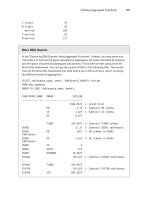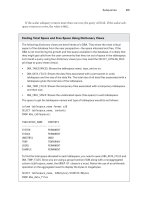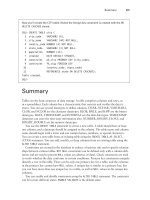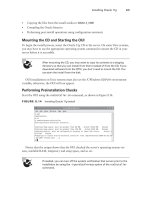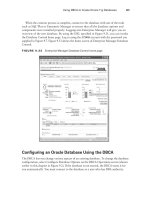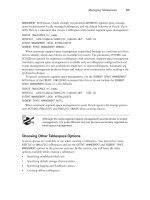Tài liệu OCA: Oracle Database 11g Administrator Certified Associate- P17 pptx
Bạn đang xem bản rút gọn của tài liệu. Xem và tải ngay bản đầy đủ của tài liệu tại đây (993.59 KB, 50 trang )
Configuring Oracle Net for the Client
631
FIGURE 11.20 Choosing a network protocol
3.
The next step is to choose the hostname and port. This step depends on the protocol
you chose in the previous step. If you chose TCP/IP, you are prompted for the host-
name and the port number. The hostname is the name of the machine on which the
listener process is running. The port number is the listening location for the listener.
The default port is 1521 (see Figure 11.21).
FIGURE 11.21 Choosing a hostname and a port
4.
The next step is to define the service name. For Oracle 11g, the service name does not
have to be the same as the
ORACLE_SID
because a database can have multiple service
names. In Oracle 11g, the service name is normally the same as the global database
name. This is the service name that is supplied to the listener, so the listener has to be
listening for this service. You can also choose whether this service is for Oracle8i or
95127c11.indd 631 2/17/09 2:17:19 PM
Please purchase PDF Split-Merge on www.verypdf.com to remove this watermark.
632
Chapter 11
N
Understanding Network Architecture
later databases or Oracle8i and previous databases. You can also select the connection
type from one of these choices:
Database Default
ÛN
Shared Server
ÛN
Dedicated Server
ÛN
Figure 11.22 shows an example of the Oracle Net Manager service name screen.
5.
The last step is to test the net service name and verify that all the connection informa-
tion entered is correct. Click the Test button to test the network connection.
Click Finish button to create the
tnsnames.ora
entry. You can edit the entry, as shown
in Figure 11.23.
FIGURE 11.22 Choosing the service name
FIGURE 11.23 The Oracle Net Manager
tnsnames.ora
wizard
95127c11.indd 632 2/17/09 2:17:20 PM
Please purchase PDF Split-Merge on www.verypdf.com to remove this watermark.
Configuring Oracle Net for the Client
633
After you complete all this, save your changes by choosing File Save Network Con-
figuration. This creates and saves the
tnsnames.ora
file.
Contents and Structure of the tnsnames.ora File
You created the
tnsnames.ora
file using the Oracle Net Manager, so open the
tnsnames.ora
file to view its contents. The
tnsnames.ora
file is located at the location the
TNS_ADMIN
variable is set to, which defaults to the
$ORACLE_HOME/network/admin
directory. Here is an
example of the
tnsnames.ora
file:
OCP11G =
(DESCRIPTION =
(ADDRESS_LIST =
(ADDRESS = (PROTOCOL = TCP)(HOST = bt-dell1)(PORT = 1521))
)
(CONNECT_DATA =
(SERVICE_NAME = OCPTEST)
)
)
Table 11.6 summarizes the parameters in the
tnsnames.ora
file.
TABLE 11.6 The
tnsnames.ora
Parameters
Parameter Description
DESCRIPTION
Starts the connect descriptor section of the file.
ADDRESS_LIST
Starts a list of all connect descriptor address information.
ADDRESS
Specifies the connect descriptor for the net service name.
PROTOCOL
Specifies the protocol used, such as TCP/IP.
HOST
Specifies the name of the machine on which the listener is running. An IP
address can also be specified in TCP/IP.
PORT
Specifies the listening location of the listener specific to TCP/IP.
CONNECT_DATA
Starts the services section for this net service name.
SERVICE_NAME
Replaces the
SID
parameter from older releases of Oracle. Defines which
service to connect to, which can be the same as the
ORACLE_SID
or the
global database name. Databases can now be referred to by more than a
single service name.
95127c11.indd 633 2/17/09 2:17:20 PM
Please purchase PDF Split-Merge on www.verypdf.com to remove this watermark.
634
Chapter 11
N
Understanding Network Architecture
Configuring Local Naming Using Enterprise Manager
You can also use Oracle Enterprise Manager to configure local naming. You do so from the
Net Services Administration screen as described in the “Adding a Listener Using Enterprise
Manager Database Control” section earlier in this chapter. You will see the screen shown
in Figure 11.15. Choose Local Naming from the Administer drop-down list, and click Go
to open the Local Naming screen, as shown in Figure 11.24.
FIGURE 11.24 Using Enterprise Manager to configure local naming
1.
Click the Create button to open the Create Net Service Name page. Here you can enter
the unique service name that you want users to use to connect to this Oracle service.
This can also be the Oracle SID.
2.
Select the type of connection to use for this service: a dedicated server, shared server,
or the database default.
3.
Specify the address information. This includes the protocol, port, and host used by the
service being connected to.
4.
Click the Add button under Addresses to open the Add Address screen to fill in the
appropriate information.
On the Create New Service Name page, there is a section to configure failover and load
balancing options. Five choices are listed under the Connect Time Failover and Load Bal-
ancing section. Table 11.7 summarizes these prompts. If you have multiple listeners listening
for this service or are using Oracle Connection Manager, you can select from this list. The
default is to use the first address only; this is the case where a single listener is being used.
Source routing is used with Oracle Connection Manager. Oracle passes
control from the first address listed to the next address, and so on, until
the ultimate destination is reached. Every address listed is used in the case
of source routing.
95127c11.indd 634 2/17/09 2:17:20 PM
Please purchase PDF Split-Merge on www.verypdf.com to remove this watermark.
Configuring Oracle Net for the Client
635
TABLE 11.7 Advanced-Features Summary
Option Advanced Feature
Try each address, in order, until one succeeds. Failover
Try each address, randomly, until one succeeds. Failover Load Balancing
Try one address, selected at random. Load Balancing
Use each address in order until you reach the destination. Source Routing
Use only the first address. None
Troubleshooting Client-Side Connection Problems
Connection problems can also occur from the Oracle client. Several areas affect the ability
of a client to connect successfully to the server. The client must be able to contact both the
computer on which the Oracle server is located and the listener listening for connections to
the Oracle server. The client must also be able to resolve the net service name. Let’s look at
the checks to perform on the client to verify connectivity to the Oracle server and to detect
and troubleshoot client-side connection problems. Use the following list to help you system-
atically check various aspects of the client connection process:
Verify that the client can contact the server.
ÛN
Determine the network route that the client is taking to the server.
ÛN
Verify local naming configuration files.
ÛN
Check for multiple-client network configuration files.
ÛN
Check network file locations.
ÛN
Check the
ÛN
NAMES.DIRECTORY_PATH
parameter.
Check the
ÛN
NAMES.DEFAULT_DOMAIN
parameter.
Check the client protocol adapters installed.
ÛN
Check for any common client-side error codes.
ÛN
Oracle provides the
tnsping
utility to verify that the local naming entry
defined in the
tnsnames.ora
file can talk to the service name defined in the
listener.ora
file. You can find
tnsping
in the
$ORACLE_HOME/bin
direc-
tory. It also provides the time it took to reach the listener in milliseconds.
95127c11.indd 635 2/17/09 2:17:20 PM
Please purchase PDF Split-Merge on www.verypdf.com to remove this watermark.
636
Chapter 11
N
Understanding Network Architecture
Checking Network File Locations
One of the most common problems encountered is clients moving network files and not
setting the
TNS_ADMIN
environmental variable to the new file location. Oracle expects the
tnsnames.ora
and
sqlnet.ora
files to be in the default location. If it cannot locate the files
and you have not set
TNS_ADMIN
, you receive an ORA-12154 error message. You also receive
this error if the supplied net service name is invalid or the
NAMES.DEFAULT_DOMAIN
value is
mismatched in
tnsnames.ora
and
sqlnet.ora
files. The following code shows an example
of this error message:
$ sqlplus system@ocp11r1
SQL*Plus: Release 11.1.0.6.0 - Production on Sun Aug 17 23:47:17 2008
Copyright (c) 1982, 2007, Oracle. All rights reserved.
Enter password:
ERROR:
ORA-12154: TNS: could not resolve the connect identifier specified
If you decide to move network files, be sure to set the
TNS_ADMIN
environ-
mental variable to the location of the files. Oracle first searches the default
location for the files and then searches the
TNS_ADMIN
location for the files.
Checking NAMES.DIRECTORY_PATH
Make sure the client has the proper names resolution setting. The
NAMES.DIRECTORY_PATH
parameter in the
sqlnet.ora
file controls the order in which the client resolves net service
names. If the parameter is not set, the default is local naming, OID, and then host naming.
If this parameter is set incorrectly, the client may never check the appropriate names
resolution type. For example, if you are using local naming and the parameter is set to
HOSTNAMES
, the
tnsnames.ora
file will never be used to resolve the net service name. You will
receive an ORA-12154 “Could Not Resolve the Connect Identifier Specified” error message.
Checking NAMES.DEFAULT_DOMAIN
NAMES.DEFAULT_DOMAIN
is another common error. It was more common in older releases of
Oracle because the parameter defaulted to the value
WORLD
. Check the client
sqlnet.ora
file
to see whether the parameter is set. If the parameter has a value and you are using unquali-
fied net service names, the parameter value is appended to the end of the net service name.
An unqualified service name is a service name that does not contain domain information.
For example, if you entered
sqlplus matt/casey@PROD
and the
NAMES.DEFAULT_DOMAIN
is
set to
WORLD
, Oracle appends
.WORLD
to the net service name; as a result, Oracle passes the
95127c11.indd 636 2/17/09 2:17:20 PM
Please purchase PDF Split-Merge on www.verypdf.com to remove this watermark.
An Overview of Oracle Shared Server
637
command as
sqlplus matt/
. You will receive an ORA-12154 “Could
Not Resolve the Connect Identifier Specified” error message if the service name should not
include the
.WORLD
domain extension. You use this parameter only if you are using a hierar-
chical naming convention.
Checking for Client-Side Error Codes
You should next check for client-side error codes. Here is a summary of some of the com-
mon client-side Oracle error messages you might encounter. They are discussed in detail in
the following sections.
ORA-12154 “TNS: could not resolve connect identifier specified”
ORA-12198 “TNS: could not find path to destination”
ORA-12203 “TNS: Unable to connect to destination”
ORA-12533 “TNS: illegal address parameters”
ORA-12541 “TNS: No listener”
ORA-12154 This indicates that the client cannot find the service listed in the
tnsnames.
ora
file. Some of the causes of this were previously described, such as the file is not in the
proper directory or the
TNS_ADMIN
variable is not specified or specified incorrectly.
ORA-12198 and ORA-12203 This indicates that the client found an entry for the service
in the
tnsnames.ora
file but the service specified was not found. Check to make sure the
service specified in the
tnsnames.ora
file actually points to a valid database service.
ORA-12533 This indicates that you have configured the
ADDRESS
section of the
tnsnames.
ora
file incorrectly. Check to make sure the syntax is correct, or re-create the definition
using the Oracle Net Manager tool.
ORA-12541 This indicates that the client contacted a server that does not have a listener
running on the specified port. Make sure the listener is started on the server and that the
listening port specifications on the client and the server match.
An Overview of Oracle Shared Server
Oracle Shared Server is an optional configuration of Oracle Server that allows the server
to support a larger number of concurrent connections without increasing physical resource
requirements. It does so by sharing resources among groups of users.
Shared Server is suitable for high-think applications. High-think applications are com-
posed of small transactions with natural pauses in the transaction patterns, which makes
them good candidates for Oracle Shared Server connections. Many web-based applications
fit this model. These types of applications are typically form-based and involve submissions
of small amounts of information to the database with small result sets returned to the client.
95127c11.indd 637 2/17/09 2:17:20 PM
Please purchase PDF Split-Merge on www.verypdf.com to remove this watermark.
638
Chapter 11
N
Understanding Network Architecture
Oracle manages dedicated server and shared server connections differently. As a DBA,
you need to be able to identify these differences. This knowledge will help you better under-
stand the advantages and disadvantages of Oracle Shared Server and when it might be
advantageous to use Oracle Shared Server in your environment.
Dedicated Server vs. Shared Server
If you have ever gone to an upscale restaurant, you may have had your own personal wait-
person. That waitperson is there to greet you and escort you to your seat. They take your
order for food and drinks and even help prepare your order. No matter how many other
patrons enter the restaurant, your waitperson is responsible for serving only your requests.
Therefore, your service is consistent—if the person is a good waitperson.
A dedicated server environment works in much the same way. Every client connection
is associated with a dedicated server process, sometimes called a shadow process, on the
machine where the Oracle server exists. No matter how many other connections are made to
the server, the same dedicated server is always responsible for processing only your requests.
You use the services of that server process until you disconnect from the Oracle server.
Most restaurants operate more like shared servers. When you walk in, you are assigned
a waitperson, but they may be responsible for serving many other tables. This is good for
the restaurant because they can serve more customers without increasing the staff. It may
be fine for you as well, if the restaurant is not too busy and the waitperson is not respon-
sible for too many tables. Also, if most of the orders are small, the staff can keep up with
the requests, and the service will be as good as if you had your own waitperson.
In a diner, things work slightly different; the waitperson takes your order and places it
on a turnstile. If the diner has multiple cooks, the order is picked up from the turnstile and
prepared by one of the available cooks. When the cook completes the preparation of the
dinner, it is placed in a location where the waitperson can pick it up and bring it to your
table.
This is how an Oracle Shared Server environment works. In an Oracle Shared Server
environment, dispatcher processes are responsible for servicing client requests. These
processes are capable of handling requests from many clients. This is different from the
dedicated server environment, where a single client process is handled by a single server
process. Like the waitperson in the diner, a dispatcher can be responsible for taking the
orders of many clients.
When using Oracle Shared Server, idle connections can be reused and
allow several users to connect to the database, thus improving scalability.
When you request something from the server, it is the dispatcher’s responsibility to take
your request and place it in a location called a request queue. The request queue functions
95127c11.indd 638 2/17/09 2:17:20 PM
Please purchase PDF Split-Merge on www.verypdf.com to remove this watermark.
An Overview of Oracle Shared Server
639
like the turnstile in the diner analogy. All dispatcher processes place their client requests in
one request queue, which is a structure contained in the system global area (SGA).
Shared Server processes, like cooks in a diner, are responsible for fulfilling the client
requests. The Oracle Shared Server process executes the request and places the result into
an area of the SGA called a response queue. Every dispatcher has its own response queue.
The dispatcher picks up the completed request from the response queue and returns the
results to the client. Figure 11.25 illustrates the following processing steps for a Shared
Server request:
1.
The client passes a request to the dispatcher serving it.
2.
The dispatcher places the request on a request queue in the SGA.
3.
One of the Shared Server processes executes the request.
4.
The Shared Server places the completed request on the dispatchers’ response queue of
the SGA.
5.
The dispatcher picks up the completed request from the response queue.
6.
The completed request is passed back to the client.
FIGURE 11.25 Request processing in Shared Server
SQL>SELECT ename
FROM emp;
ENAME
------------
SMITH
JONES
2 rows selected.
Dispatcher
Process
Client Computer Server Computer
Request Queue Response Queue
Shared Server
Process
Oracle
SGA
3
4
1
2
5
6
95127c11.indd 639 2/17/09 2:17:21 PM
Please purchase PDF Split-Merge on www.verypdf.com to remove this watermark.
640
Chapter 11
N
Understanding Network Architecture
Requests placed in the request queue are processed on a first-in, first-out
basis (FIFO). Currently, there is no way to prioritize requests within the
queue.
Advantages and Disadvantages of Shared Server
Oracle Shared Server is used when server resources, such as memory and active processes,
become constrained. People tend to throw more hardware at problems such as these; this
will likely remedy the problem, but it may be an unnecessary expense.
If your system is experiencing these problems, Oracle Shared Server allows you to sup-
port the same number or a greater number of connections without requiring additional
hardware. As a result, Oracle Shared Server tends to decrease the overall memory and pro-
cess requirements on the server. Because clients are sharing processes, the total number of
processes is reduced. This translates into resource savings on the server.
Shared Server also allows for connection pooling. Connection pooling enables the data-
base server to disconnect an idle Oracle Shared Server connection to service an incoming
request. The idle connection is still active and is reenabled once the client makes the next
request. The connection pooling feature of Oracle Shared Server allows it to handle a larger
number of requests without having to start additional dispatcher processes. You configure
connection pooling by adding attributes to one of the Oracle Shared Server parameters.
See the section “Configuring Connection Pooling with the Dispatch-
ers Parameter” later in this chapter to see how connection pooling is
configured.
Shared Server is also required to take advantage of certain network options, such as
connection multiplexing and client access control, which are features of Oracle Connection
Manager. Oracle Connection Manager is a facility provided by Oracle that controls access
to database services and multiplex connections in an Oracle environment. The access con-
trol component of Oracle Connection Manager allows you to configure rules that allow or
disallow fulfillment of a connection request. The multiplexing component acts as a concen-
trator feature. It funnels multiple client sessions through a shared network connection from
the Oracle Connection Manager server to the database server.
You can find out more about Oracle Connection Manager in “Oracle Data-
base Net Services Administrators Guide 11g Release 1 (11.1) Part Number
B28316-04.”
Oracle Shared Server also has some disadvantages. Applications that generate a signifi-
cant amount of network traffic or result in large result sets are not good candidates for
Shared Server connections. Think of the earlier diner analogy. Your service is fine until
95127c11.indd 640 2/17/09 2:17:21 PM
Please purchase PDF Split-Merge on www.verypdf.com to remove this watermark.
Oracle Shared Server Infrastructure
641
two parties of twelve people show up. All of a sudden, the waitperson is overwhelmed with
work from these two other tables, and your service begins to suffer. The same thing would
happen in a Shared Server environment. If requests for large quantities of information start
going to the dispatchers, the dispatchers can become overwhelmed, and you can see perfor-
mance suffer for the other clients connected to the dispatcher. This, in turn, increases your
response times. Dedicated processes better serve these types of applications.
Some functions are not allowed when you are using an Oracle Shared Server connection.
You cannot start up, shut down, or perform certain kinds of recovery of an Oracle server
when you are connected via a shared server.
Also, you should not perform certain administrative tasks using Oracle Shared Server
connections, including bulk loads of data, index and table rebuilds, and table analysis.
These types of tasks deal with manipulating large data sets and should use dedicated
connections.
Oracle Shared Server is a scalability enhancement option, not a performance enhance-
ment option. If you are looking for a performance increase, Shared Server is not what you
should be configuring. Use Shared Server only if you are experiencing the system constraint
problems discussed earlier in this chapter. You will always have equal or better perfor-
mance in a dedicated server environment.
Oracle Shared Server Infrastructure
As described in the previous section, you manage client connections quite differently when
using Oracle Shared Server as opposed to using a dedicated server. To accommodate the
change, several modifications take place inside the internal memory structures of the Ora-
cle server. The way in which the database and listener interact is also affected when using
Oracle Shared Server. It is important to understand these changes when configuring and
managing Oracle Shared Server.
Certain changes are necessary to the memory structures within Oracle to provide the
Shared Server capability. Let’s see what changes within the Oracle infrastructure are neces-
sary to provide this support.
PGA and SGA Changes When Using
Oracle Shared Server
When Oracle Shared Server is configured, Oracle adds two new types of structures to the
SGA: request queues and response queues. These structures do not exist in a dedicated
server environment. There is one request queue for all dispatchers, but each dispatcher has
its own response queue. Therefore, if you have four dispatchers, you will have one request
queue and four response queues. The request queue is located in the SGA where the dis-
patcher places client requests. A Shared Server process executes each request and places the
completed request in the dispatcher’s response queue.
95127c11.indd 641 2/17/09 2:17:21 PM
Please purchase PDF Split-Merge on www.verypdf.com to remove this watermark.
642
Chapter 11
N
Understanding Network Architecture
In a dedicated server environment, each server has a memory segment called a program
global area (PGA). The PGA is an area of memory where information about each client ses-
sion is maintained. This information includes bind variables, cursor information, and the
client’s sort area. In an Oracle Shared Server environment, this information is moved from
the PGA to an area of the SGA called the user global area (UGA). You can configure a spe-
cial area of the SGA called the large pool to accommodate the bulk of the UGA.
Figure 11.26 shows how the SGA and PGA structures differ between a dedicated server
and an Oracle Shared Server environment.
Each connection being serviced by a dispatcher is bound to a shared memory segment
and forms a virtual circuit. The dispatcher uses the shared memory segment to manage
communications between the client and the Oracle Database. The Oracle Shared Server
processes use the virtual circuits to send and receive information to the appropriate dis-
patcher process.
To limit the amount of UGA memory a session can allocate, set the
PRIVATE_SGA
resource limit in the user’s profile.
The Role of the Listener in an Oracle
Shared Server Environment
The listener plays an important role in the Oracle Shared Server environment. The listener
supplies the client with the address of the dispatcher to connect to when a user requests
connections to an Oracle Shared Server. The listener maintains a list of dispatchers avail-
able from the Oracle Shared Server. The Oracle background process PMON notifies the
listener as to which dispatcher is responsible for servicing each virtual circuit. The listener
is then aware of the number of connections that the dispatcher is managing. This informa-
tion allows the listener to take advantage of dispatcher load balancing.
Load balancing allows the listener to make intelligent decisions about which dispatcher
to redirect client connections to so that no one dispatcher becomes overburdened. When
the listener receives a connection request, it looks at the current connection load for each
dispatcher and redirects the client connection request to the least-loaded dispatcher. The
listener determines the least-loaded dispatcher for all nodes if Real Application Clusters
(RAC) are being used, followed by the least-loaded instance for the node, and finally by the
least-loaded dispatcher for the instance. By doing so, the listener ensures that connections
are evenly distributed across dispatchers.
The listener can either redirect the client connection to an available dispatcher or
directly hand off the request to the dispatcher. The latter is performed whenever possible
and is done typically when the listener and database service exist on the same node. When
the listener and database service exist on different nodes, the redirection method is used.
95127c11.indd 642 2/17/09 2:17:21 PM
Please purchase PDF Split-Merge on www.verypdf.com to remove this watermark.
Oracle Shared Server Infrastructure
643
FIGURE 11.26 SGA/PGA comparison of dedicated server and shared server
Database
Buffer Cache
Shared Server SGA
Dedicated Server PGA
Shared Pool
Dictionary
Cache
Library
Cache
Large PoolRedo-Log
Buffer
Database
Buffer Cache
Shared Pool
Dictionary
Cache
Library
Cache
Redo-Log
Buffer
Dedicated Server SGA
User Global Area
Request Queue Dispatcher Response Queue Dispatcher Response Queue
User Global Area
User Global Area
User Global Area
Cursor State
User Session Data
Stack Space
Shared Server PGA
Stack Space
When a client connection terminates, the listener is updated to reflect the change in the
number of connections that the dispatcher is handling.
Figure 11.27 illustrates the following steps in the Oracle Shared Server connection pro-
cess after the database has been started and the dispatcher processes have been started:
1.
The client contacts the Oracle Database server after resolving the service name.
2.
The listener validates the Oracle service name supplied by the client and hands off or
redirects the client connection to the least-busy dispatcher.
95127c11.indd 643 2/17/09 2:17:21 PM
Please purchase PDF Split-Merge on www.verypdf.com to remove this watermark.
644
Chapter 11
N
Understanding Network Architecture
3.
The listener sends information to the client so the client can redirect the connection to
the appropriate dispatcher process.
4.
The dispatcher process manages the client server request.
5.
PMON registers connection information with the listener.
FIGURE 11.27 The Shared Server connection process
sqlplus scott/tiger@iprd
Client Computer
Oracle Server
Server
or Dispatcher
Process
Listener
on Server
PMON
4
5
2
3
1
Configuring the Oracle Shared Server
You can configure Oracle Shared Server in a number of ways. You can configure it at the
time the database is created, you can use Enterprise Manager to configure it after the data-
base has been created, or you can manually configure it by editing initialization param-
eters. I’ll discuss the parameters necessary to configure Oracle Shared Server. I’ll also give
examples of how to configure Shared Server at database creation or after the database is
created using EM.
Defining the Shared Server Parameters
You configure Oracle Shared Server by adding parameters to the Oracle initialization file.
These parameters identify the number and type of dispatchers, the number of shared serv-
ers, and the name of the database you want to associate with Shared Server.
One advantage of Oracle 11g is that all the parameters necessary to manage Oracle
Shared Server can be changed dynamically. This fulfills one of your primary goals of ensur-
ing the highest degree of database availability possible. Let’s take a look at the parameters
used to manage Oracle Shared Server.
95127c11.indd 644 2/17/09 2:17:21 PM
Please purchase PDF Split-Merge on www.verypdf.com to remove this watermark.
Oracle Shared Server Infrastructure
645
Using the DISPATCHERS Parameter
The
DISPATCHERS
parameter defines the number of dispatchers that should start when the
instance is started. This parameter specifies the number of dispatchers and the type of pro-
tocol to which the dispatchers can respond. If you configured your database using the Data-
base Configuration Assistant, this parameter may already be configured.
You can add dispatchers dynamically using the
ALTER SYSTEM
command.
The
DISPATCHERS
parameter has a number of optional attributes. Table 11.8 describes sev-
eral of them. You need to specify only
ADDRESS
,
DESCRIPTION
, or
PROTOCOL
for a
DISPATCHERS
definition. All the attributes for this parameter can be abbreviated.
TABLE 11.8 Summary of
DISPATCHER
Attributes
Attribute Abbreviations Description
ADDRESS ADD
or
ADDR
Specifies the network protocol address of the end point on
which the dispatchers listen.
CONNECTIONS CON
or
CONN
The maximum number of network connections per dis-
patcher. The default value varies by operating system.
DESCRIPTION DES
or
DESC
The network description of the end point where the dis-
patcher is listening, including the protocol being listened for.
DISPATCHERS DIS
or
DISP
The number of dispatchers to start when the instance is
started. The default is 1.
LISTENER LIS
or
LIST
The address of the listener to which PMON sends connec-
tion information. This attribute needs to be set only when
the listener is nonlocal, it uses a port other than 1521, the
default port and the
LOCAL_LISTENER
parameter have not
been specified, or the listener is resident on a different
network node.
PROTOCOL PRO
or
PROT
The network protocol for the dispatcher to listen for. This
is the only required attribute.
SESSIONS SES
or
SESS
The maximum number of network sessions allowable for
this dispatcher. This will vary by operating system but pre-
dominantly defaults to 16KB.
SERVICE SER
or
SERV
The Oracle net service name that the dispatcher registers
with the listener. If it is not supplied, the dispatcher regis-
ters with the services listed in the
SERVICE_NAMES
initializa-
tion parameter.
POOL POO
Provides connection pooling capabilities to provide the
ability to handle a larger number of connections.
95127c11.indd 645 2/17/09 2:17:21 PM
Please purchase PDF Split-Merge on www.verypdf.com to remove this watermark.
646
Chapter 11
N
Understanding Network Architecture
The two main attributes are
DISPATCHERS
and
PROTOCOL
. For example, if you want to
configure three TCP/IP dispatchers and two IPC dispatchers, you set the parameter as
follows:
DISPATCHERS = “(PRO=TCP)(DIS=3)(PRO=IPC)(DIS=2)”
You must consider several factors (discussed in the following section) when determining
the appropriate setting for the
DISPATCHERS
parameter.
DETERMINING THE NUMBER OF DISPATCHERS TO START
The number of dispatchers you start depends on your particular configuration. Your oper-
ating system may place a limit on the number of connections that one dispatcher can han-
dle. Consult your operating-system documentation to obtain this information.
When determining the number of dispatchers to start, consider the type of work that
the database sessions will be performing and the number of concurrent connections that
your database will be supporting. The more data-intensive the operations and the larger the
number of concurrent connections, the fewer sessions each dispatcher should handle. Gen-
erally speaking, a starting point is to allow 50 concurrent sessions for each dispatcher.
You can use the following formula to determine the number of dispatchers to configure
initially:
Number of Dispatchers = CEIL (maximum number of concurrent sessions /
connections per dispatcher)
For example, if you have 500 concurrent TCP/IP connections and you want each dispatcher
to manage 50 concurrent connections, you need 10 dispatchers. You set your
DISPATCHERS
parameter as follows:
DISPATCHERS = “(PRO=TCP)(DIS=10)”
You can determine the number of concurrent connections by querying the
V$SESSION
view. This view shows you the number of clients currently connected to the Oracle server.
Here is an example of the query:
SQL> select sid,serial#,username,server,program from v$session
2 where username is not null;
SID SERIAL# USERNAME SERVER PROGRAM
--------- --------- ---------- --------- ---------------
7 13 SCOTT DEDICATED SQLPLUS.EXE
8 12 SCOTT DEDICATED SQLPLUS.EXE
9 4 SYSTEM DEDICATED SQLPLUS.EXE
In this example, three users are connected to the server. You can ignore any sessions that
do not have a username because these would be the Oracle background processes such as
PMON and SMON. If you take a sampling of this view over a typical work period, you get
an idea of the average number of concurrent connections for your system. You can then use
this number as a guide when you establish the starting number of dispatchers.
95127c11.indd 646 2/17/09 2:17:22 PM
Please purchase PDF Split-Merge on www.verypdf.com to remove this watermark.
Oracle Shared Server Infrastructure
647
MANAGING THE NUMBER OF DISPATCHERS
You can start additional dispatchers or remove dispatchers dynamically using the
ALTER
SYSTEM
command. You can start any number of dispatchers up to the
MAX_DISPATCHERS
set-
ting, which is discussed next. Here is an example of adding three TCP/IP dispatchers to a
system configured with two TCP/IP dispatchers:
ALTER SYSTEM SET DISPATCHERS=”(PRO=TCP)(DIS=5)”;
Notice that you set the number to the total number of dispatchers you want, not to the
number of dispatchers you want to add.
You use additional attributes to the
DISPATCHERS
parameter to configure connection
pooling.
CONFIGURING CONNECTION POOLING WITH THE DISPATCHERS PARAMETER
Connection pooling gives Oracle Shared Server the ability to handle a larger volume of con-
nections by automatically disconnecting idle connections and using the idle connections to
service incoming client requests. If the idle connections become active again, the connection
to the dispatchers is automatically reestablished. This provides added scalability to Oracle
Shared Server. If you manage applications that have a large number of possible client con-
nections but also have a large number of idle connections, you might want to consider
configuring this Oracle Shared Server option. Web applications are good candidates for
connection pooling because they are typically composed of a large client base with small
numbers of concurrent connections.
You enable connection pooling by adding attributes to the
DISPATCHERS
parameter. The
POOL
attribute specifies that a dispatcher is allowed to perform connection pooling. Set this
attribute to the value
ON
to enable connection pooling for a dispatcher. You also need to
specify the
TICK
attribute, which sets the number of 10-minute increments of inactivity for
a connection to be considered idle.
Here is an example that turns on connection pooling:
DISPATCHERS=”(PROTOCOL=tcp)(DISPATCHERS=1)(POOL=on)(TICK=1)
(CONNECTIONS=500)(SESSIONS=1000)”
In this example, you want to turn on connection pooling. An idle connection is con-
sidered any connection with 10 minutes of inactivity. You want the TCP/IP dispatcher to
handle a maximum of 500 concurrent connections and a maximum of 1,000 sessions per
dispatcher.
Using the MAX_DISPATCHERS Parameter
You set the
MAX_DISPATCHERS
parameter to the maximum number of dispatchers you antici-
pate needing for Oracle Shared Server. In Oracle 11g, this parameter can be set dynamically
using the
ALTER SYSTEM
command. The maximum number of processes that a dispatcher
can run concurrently is operating system–dependent. Use the following formula to set this
parameter:
MAX_DISPATCHERS = (maximum number of concurrent sessions/connections
per dispatcher)
95127c11.indd 647 2/17/09 2:17:22 PM
Please purchase PDF Split-Merge on www.verypdf.com to remove this watermark.
648
Chapter 11
N
Understanding Network Architecture
Here is an example of the parameter and adjusting the parameter using the
ALTER
SYSTEM
command:
ALTER SYSTEM SET MAX_DISPATCHERS=10;
In the
ALTER SYSTEM
example, the
MAX_DISPATCHERS
parameter is being set to 10.
This will be the maximum number of dispatchers that Oracle Shared Server can start
simultaneously.
Using the SHARED_SERVERS Parameter
The
SHARED_SERVERS
parameter specifies the minimum number of shared servers to start
and retain when the Oracle instance is started. A setting of 0 or no setting means that
shared servers will not be used. If dispatchers have been configured, the default value of
SHARED_SERVERS
is 1. This parameter can be changed dynamically, so even if shared servers
are not configured when the instance starts, they can be configured without bringing the
Oracle instance down and restarting it.
The number of servers necessary depends on the type of activities your users are perform-
ing. Oracle monitors the response queue loads, starts additional shared servers as needed,
and removes these shared servers when the servers are no longer needed. Generally, for the
types of high-think applications that will be using shared server connections, 25 concurrent
connections per shared server should be adequate. If the users are going to require larger
result sets or are doing more intensive processing, you’ll want to reduce this ratio.
Here is an example of setting the
SHARED_SERVERS
parameter:
SHARED_SERVERS = 3
You can start additional Oracle shared servers or reduce the number of Oracle shared
servers dynamically using the
ALTER SYSTEM
command. You can start any number of Oracle
shared servers up to the
MAX_SERVERS
setting. Here is an example of adding three additional
Oracle shared servers to a system initially configured with two shared servers:
ALTER SYSTEM SET SHARED_SERVERS = 5;
Notice that you set the number to the total number of Oracle shared servers you want,
not to the number of Oracle shared servers you want to add.
Using the SHARED_SERVER_SESSIONS Parameter
The
SHARED_SERVER_SESSIONS
parameter specifies the total number of Oracle Shared Server
sessions that are allowed for the Oracle instance. If the number of Oracle Shared Server cli-
ent connections reaches this limit, any clients that attempt to connect via an Oracle Shared
Server connection will receive the following error message:
ERROR:
ORA-00018 maximum number of sessions exceeded
Once the number of Oracle Shared Server connections falls below this number, addi-
tional Shared Server connections can be established. Using this parameter limits the total
number of Shared Server sessions. Dedicated server connections are still allowed if this
limit is reached. This parameter can be set in the Oracle initialization file and can be
95127c11.indd 648 2/17/09 2:17:22 PM
Please purchase PDF Split-Merge on www.verypdf.com to remove this watermark.
Oracle Shared Server Infrastructure
649
modified dynamically using the
ALTER SYSTEM
command. Here is an example of how you
specify the initialization parameter:
SHARED_SERVER_SESSIONS = 2
Here is an example of how to dynamically modify the parameter using the
ALTER SYSTEM
command:
ALTER SYSTEM SET SHARED_SERVER_SESSIONS = 5;
Using the MAX_SHARED_SERVERS Parameter
The
MAX_SHARED_SERVERS
parameter sets the maximum number of Oracle shared servers
that can be running concurrently. This number can be modified dynamically using the
ALTER SYSTEM
command. Generally, you should set this parameter to accommodate your
heaviest work times. If no value is specified for
MAX_SHARED_SERVERS
, the number of Oracle
shared servers that can be started is unlimited, which is also the default setting.
The
V$SHARED_SERVER_MONITOR
view can assist in determining the maximum number of
Oracle shared servers that have been started since the Oracle instance was started.
Here is an example of the parameter and the
ALTER SYSTEM
command that will change
the value
MAX_SHARED_SERVER
to 20:
ALTER SYSTEM SET MAX_SHARED_SERVERS = 20;
Using the CIRCUITS Parameter
The
CIRCUITS
parameter manages the total number of virtual circuits allowed for all
incoming and outgoing network sessions. There is no default value for this parameter, and
it does influence the total size of the SGA at system startup. Generally, you do not manually
configure this parameter unless there is a need to specifically limit the number of virtual
circuits.
Here is an example of the parameter:
CIRCUITS = 200
You can also use the
ALTER SYSTEM
command to change the parameter as follows:
ALTER SYSTEM SET CIRCUITS = 300;
Now that you understand the parameters that are needed to use the Oracle Shared
Server, you need to know how to configure these parameters.
Managing a Shared Server
If the Oracle Shared Server parameters were configured dynamically using the
ALTER
SYSTEM
command or at database creation, it isn’t necessary to stop and start the server.
After you configure the Oracle Shared Server parameters, you need to understand how to
view information about Oracle Shared Server. Oracle provides a set of dynamic performance
views that you can use to gather information about the Oracle Shared Server configuration
and the performance of Oracle Shared Server. You can also gather information about Oracle
Shared Server connections by using the
lsnrctl
utility.
95127c11.indd 649 2/17/09 2:17:22 PM
Please purchase PDF Split-Merge on www.verypdf.com to remove this watermark.
650
Chapter 11
N
Understanding Network Architecture
In the following sections, I will explain how to display information about Oracle Shared
Server connections using the listener utility and discuss the various dynamic performance
views used to manage Shared Server.
Displaying Information about Shared Server Connections Using
the Listener Utility
You can use the
lsnrctl
command-line listener utility to display information about the
dispatcher processes. Remember from the previous section that the Oracle background pro-
cess PMON registers dispatcher information with the listener. The listener keeps track of
the current connection load for all the dispatchers.
Use the
lsnrctl services
query to view information about dispatchers. The following
example shows a listener listening for two TCP/IP dispatchers:
$ lsnrctl services
LSNRCTL for Linux: Version 11.1.0.6.0 - Production on 18-AUG-2008 00:01:47
Copyright (c) 1991, 2007, Oracle. All rights reserved.
Connecting to (DESCRIPTION=(ADDRESS=(PROTOCOL=TCP)(HOST=localhost.localdomain)
(PORT=1521)))
Services Summary...
Service “11GR11” has 1 instance(s).
Instance “11GR11”, status READY, has 2 handler(s) for this service...
Handler(s):
“DEDICATED” established:21 refused:0 state:ready
LOCAL SERVER
“D000” established:0 refused:0 current:0 max:1000 state:ready
DISPATCHER <machine: localhost.localdomain, pid: 3375>
(ADDRESS=(PROTOCOL=tcp)(HOST=localhost.localdomain)(PORT=30767))
Service “11GR11XDB” has 1 instance(s).
Instance “11GR11”, status READY, has 0 handler(s) for this service...
Notice that the listing displays how many connections each dispatcher is managing, the
listening location of the dispatcher, and the process ID of the dispatcher. The display also
shows how many total client connections were established and how many were refused by
each dispatcher since the time it was started. This summary information can be helpful
when looking at how well the connections are balanced across all the dispatchers. It also
can be helpful to see how many connections were refused. A connection can be refused if
a user supplies an invalid user ID or password or reaches the
MAX_SHARED_SERVER
limit.
Requesting a Dedicated Connection in a Shared Server Environment
You can configure Oracle Shared Server connections and dedicated server connections
to connect to a single Oracle server. This is advantageous if you have a mix of database
95127c11.indd 650 2/17/09 2:17:22 PM
Please purchase PDF Split-Merge on www.verypdf.com to remove this watermark.


